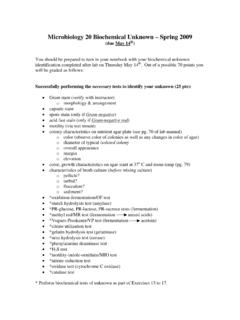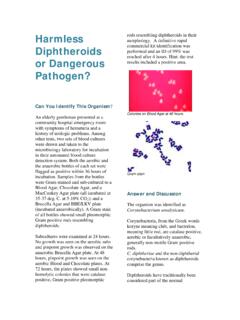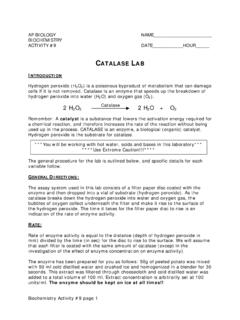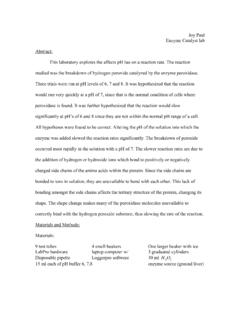Transcription of GCSE F BIOLOGY - AQA
1 SPECIMEN MATERIAL GCSE BIOLOGY Foundation Tier Paper 1F Specimen 2018 Time allowed: 1 hour 45 minutes Materials For this paper you must have: a ruler a calculator. Instructions Answer all questions in the spaces provided. Do all rough work in this book. Cross through any work you do not want to be marked. Information There are 100 marks available on this paper. The marks for questions are shown in brackets. You are expected to use a calculator where appropriate. You are reminded of the need for good English and clear presentation in your answers. When answering questions , and you need to make sure that your answer: is clear, logical, sensibly structured fully meets the requirements of the question shows that each separate point or step supports the overall answer. Advice In all calculations, show clearly how you work out your answer. F Please write clearly, in block capitals.
2 Centre number Candidate number Surname Forename(s) Candidate signature 2 SPECIMEN MATERIAL 0 1 Figure 1 shows a diagram of the human heart. Figure 1 0 1 . 1 What part of the heart is labelled A? [1 mark] Tick one box. Aorta Atrium Valve Ventricle 3 SPECIMEN MATERIAL 0 1 . 2 Where does the pulmonary artery take blood to? [1 mark] Tick one box. Brain Liver Lungs Stomach 0 1 . 3 Circle a valve on Figure 1. [1 mark] Question 1 continues on the next page 4 SPECIMEN MATERIAL The coronary arteries supply blood to the heart. Figure 2 shows two coronary arteries. Figure 2 0 1 . 4 Describe two ways the healthy artery is different from the artery affected by coronary heart disease. [2 marks] 1 2 0 1.
3 5 What can be used to treat people with coronary heart disease? [2 marks] Tick two boxes. Antibiotics Hormones Statins Stent Vaccination 5 SPECIMEN MATERIAL 0 1 . 6 Suggest two risk factors for coronary heart disease. [2 marks] 1 2 Question 1 continues on the next page 6 SPECIMEN MATERIAL Figure 3 shows the percentages of adults in the UK who have coronary heart disease. Figure 3 0 1 . 7 Calculate the difference in the percentage of male and female adults aged 65 and over who have coronary heart disease. [1 mark] % 7 SPECIMEN MATERIAL 0 1 . 8 Which is the correct conclusion for the data in Figure 3? [1 mark] Tick one box. Children do not suffer from coronary heart disease More males suffer from coronary heart disease than females More younger people suffer from coronary heart disease than older people Turn over for the next question 8 SPECIMEN MATERIAL 0 2 catalase is an enzyme.
4 catalase controls the following reaction: A student did an investigation on catalase activity. This is the method used. 1. Put 1 cm3 hydrogen peroxide solution in a test tube. 2. Add 1 cm3 of catalase solution. Bubbles of oxygen are produced. Bubbles cause foam to rise up the tube. 3. Measure the maximum height of the foam. Figure 4 shows the experiment. Figure 4 The experiment is carried out at 20 C. 9 SPECIMEN MATERIAL Table 1 shows some results from the investigation. Table 1 Temperature in C Maximum height of foam in cm Test 1 Test 2 Test 3 Mean 10 20 30 40 50 60 0 2 . 1 Why did the student carry out the experiment three times at each temperature? [1 mark] Tick one box. To make the experiment more accurate To prove the experiment was correct To show the experiment was more repeatable 0 2.
5 2 The student thought one result was an anomaly. Circle the anomaly in Table 1. [1 mark] 0 2 . 3 What did the student do with the anomalous result? [1 mark] Question 2 continues on the next page 10 SPECIMEN MATERIAL 0 2 . 4 Look at Table 1 on page 9. What conclusion can be made as the temperature increases? [1 mark] Tick one box. Decreases the rate of reaction up to 30 C Decreases the rate of reaction up to 40 C Increases the rate of reaction up to 30 C Increases the rate of reaction up to 40 C 0 2 . 5 At which temperature was catalase denatured? [1 mark] Tick one box. 10 C 30 C 40 C 60 C 0 2 . 6 The student thought the optimum temperature for catalase activity was between 30 C and 40 C. How could the investigation be improved to find a more precise value for the optimum temperature?
6 Tick one box. [1 mark] Do the experiment at 70 C and 80 C Do the experiment at 30 C, 35 C and 40 C Use less hydrogen peroxide solution Use more catalase solution 11 SPECIMEN MATERIAL 0 2 . 7 Amylase is the enzyme that controls the breakdown of starch to glucose. Describe how the student could investigate the effect of pH on the breakdown of starch by amylase. [4 marks] Turn over for the next question 12 SPECIMEN MATERIAL 0 3 Figure 5 shows a human cheek cell viewed under a light microscope. Figure 5 0 3 . 1 Label the nucleus and cell membrane on Figure 5. [2 marks] 0 3 . 2 Cheek cells are a type of body cell. Body cells grow through cell division. What is the name of this type of cell division? [1 mark] Tick one box. Differentiation Mitosis Specialisation 0 3.
7 3 Ribosomes and mitochondria are not shown in Figure 5. What type of microscope is needed to see ribosomes and mitochondria? [1 mark] 13 SPECIMEN MATERIAL 0 3 . 4 What is the advantage of using the type of microscope you named in part [1 mark] Tick one box. Cheaper Higher magnification Lower resolution 0 3 . 5 The cheek cell in Figure 6 is magnified 250 times. The width of the cell is shown by the line D to E. Figure 6 Calculate the width of the cheek cell in micrometres ( m). Complete the following steps. [3 marks] Measure the width of the cell using a ruler mm Use the equation to work out the real width of the cell in mm: mm Convert mm to m m Question 3 continues on the next page 14 SPECIMEN MATERIAL 0 3 . 6 A red blood cell is 8 m in diameter. A bacterial cell is 40 times smaller.
8 Calculate the diameter of the bacterial cell. [1 mark] Tick one box. m m m m 15 SPECIMEN MATERIAL 0 4 Microorganisms can cause disease. 0 4 . 1 Draw one line from each disease to the correct description. [3 marks] Question 4 continues on the next page 16 SPECIMEN MATERIAL 0 4 . 2 Gonorrhoea is a sexually transmitted disease. A bacterium causes gonorrhoea. What are the symptoms of gonorrhoea? [2 marks] Tick two boxes. Headache Pain when urinating Rash Vomiting Yellow discharge Table 2 shows the number of people in the UK diagnosed with gonorrhoea in different years. Table 2 Number of people diagnosed with gonorrhoea in thousands Year Female Male 2005 2007 2009 2011 2013 17 SPECIMEN MATERIAL 0 4.
9 3 Use the data in Table 2 to complete Figure 7. The numbers for males have already been plotted. Only some of the numbers for females have been plotted. [3 marks] Figure 7 0 4 . 4 Describe the patterns in the numbers of males and females with gonorrhoea from 2005 to 2013. Use the data in Figure 7. [3 marks] Question 4 continues on the next page 18 SPECIMEN MATERIAL 0 4 . 5 Gonorrhoea is treated with an antibiotic. HIV is another sexually transmitted disease. Explain why prescribing an antibiotic will not cure HIV. [2 marks] 19 SPECIMEN MATERIAL 0 5 Anaerobic respiration happens in muscle cells and yeast cells. The equation describes anaerobic respiration in muscle cells. 0 5 . 1 How can you tell from the equation that this process is anaerobic? [1 mark] 0 5 . 2 Exercise cannot be sustained when anaerobic respiration takes place in muscle cells.
10 Explain why. [2 marks] Question 5 continues on the next page 20 SPECIMEN MATERIAL Figure 8 shows an experiment to investigate anaerobic respiration in yeast cells. Figure 8 0 5 . 3 What gas will bubble into Tube B? [1 mark] Tick one box. Carbon dioxide Nitrogen Oxygen Water vapour 21 SPECIMEN MATERIAL 0 5 . 4 Describe how you could use tube B to measure the rate of the reaction in tube A. [2 marks] 0 5 . 5 Anaerobic respiration in yeast is also called fermentation. Fermentation produces ethanol. Give one use of fermentation in the food industry. [1 mark] Turn over for the next question 22 SPECIMEN MATERIAL There are no questions printed on this page 23 SPECIMEN MATERIAL 0 6 Plants have adaptations to help defend themselves and to help them survive.















